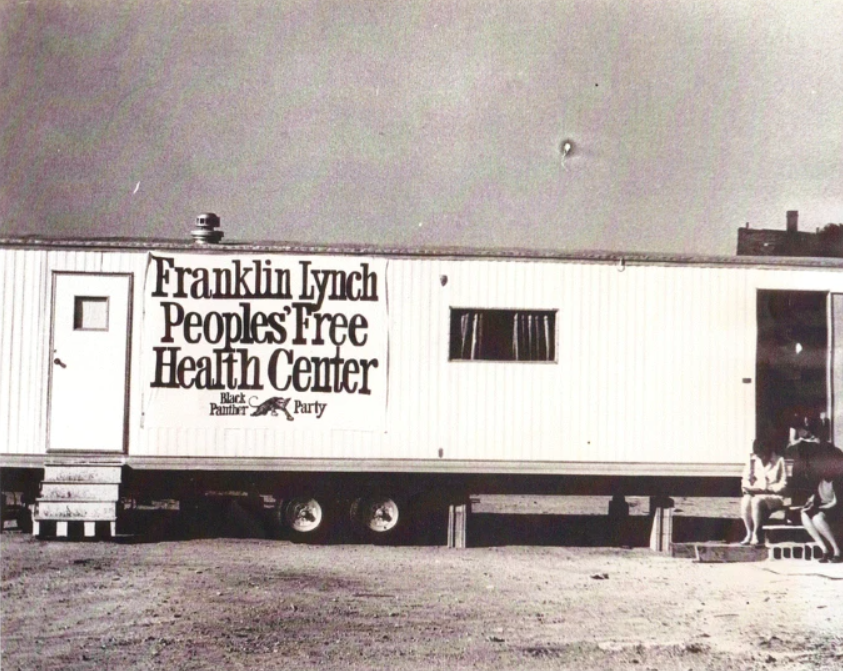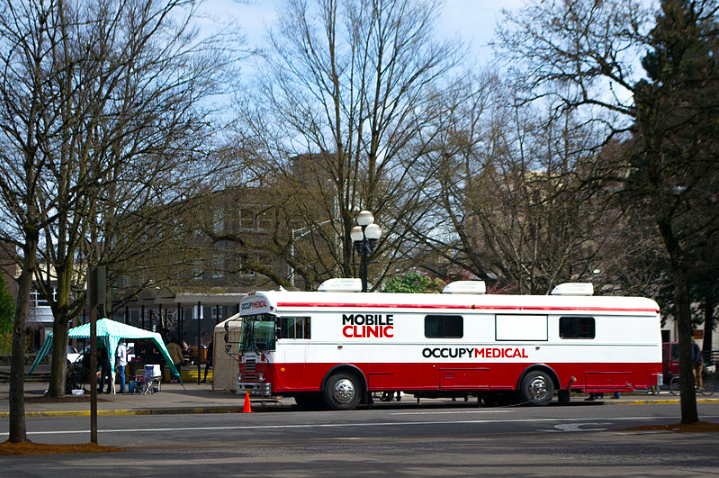6.5 Emerging Movements for Social Change in Health and Safety
We can look to recent history and to our current systems for some interesting alternatives in health and safety. They include community-run and universal programs for healthcare, initiatives to address safety outside of violence or punishment, and indigenous knowledge.
6.5.1 Public Health Care: Government Models
Clearly, concepts of health and the healthcare system itself in the United States can improve. But how does it compare to healthcare in other countries? Many people in the United States are fond of saying that this country has the best healthcare in the world. While it is true that the United States has a higher quality of care available than many peripheral or semi-peripheral nations, it is not necessarily the “best in the world.”
In a report on how U.S. healthcare compares to that of other countries, researchers found that the United States does “relatively well in some areas—such as cancer care—and less well in others—such as mortality from conditions amenable to prevention and treatment” (Docteur and Berenson 2009).
One recent change to the US health care system is the Patient Protection and Affordable Care Act (ACA). It was enacted in 2010 with the 3 primary goals:
- make affordable health insurance available to more people.
- expand the Medicaid program
- lower the costs of health care generally.
One critique of ACA is that it will create a system of socialized medicine, a term that for many people in the United States has negative connotations lingering from the Cold War era and earlier. Under a socialized medicine system, the government owns and runs the system. It employs the doctors, nurses, and other staff, and it owns and runs the hospitals (Klein 2009). The best example of socialized medicine is in Great Britain, where the National Health System (NHS) gives free healthcare to all its residents. Some critics of healthcare changes that hint of socialism don’t realize that the United States already contains one socialized system through the Veterans Health Administration.
It is important to distinguish between socialized medicine, in which the government owns the healthcare system, and universal healthcare, which is simply a system that guarantees healthcare coverage for everyone. Germany, Singapore, and Canada all have universal healthcare. People often look to Canada’s universal healthcare system, Medicare, as a model.
In Canada, healthcare is publicly funded and is administered by the separate provincial and territorial governments. However, the care itself comes from private providers. This is the main difference between universal healthcare and socialized medicine. The Canada Health Act of 1970 required that all health insurance plans must be “available to all eligible Canadian residents, comprehensive in coverage, accessible, portable among provinces, and publicly administered” (International Health Systems Canada 2010).
6.5.2 U.S. Health and Healthcare: Movements and Alternatives

Figure 6.21 Photo of the Black Panthers Party Free Medical Clinics.
The Black Panthers was a powerful organization that grew from the Black power movement in the 1960s. Many people know the Black Panthers as a militant, socialist organization.What is not widely known is the way in which they created free and accessible health programs throughout the country, as shown in Figure 6.21. These programs were designed to address the health disparities that Black and other people of color experience in the United States. Many of the Black Panthers’ health programs remain in some shape or form today. Learn more about the Black Panthers’ programs in this 2:23-minute video, “The Black Panthers’ Overlooked Health Programs” from TIME (figure 6.22).
Figure 6.22 The Black Panthers’ Overlooked Health Programs | The History You Didn’t Learn | TIME [YouTube Video]
Organizations like Occupy Medical and CAHOOTS (Crisis Assistance Helping Out On The Streets) with White Bird contain elements founded by the Black Panthers (figure 6.23). Both organizations are located in Oregon with the goal to provide free healthcare, including crisis assistance, to anyone in Eugene or Springfield. Their success is apparent in the growth of their collectives and the services they provide to all people, but especially marginalized community members such as the unhoused.

Figure 6.23 Photo of An Occupy Medical van, March 2013.
As stated on Occupy Medical’s website, “[they] believe that everyone, regardless of income or status, should have access to medical care without the fear of financial burden or being considered unimportant by their caregivers. We strive to listen to everyone who comes to our clinic, to build a positive culture in the community, and to give the best care possible at no cost to the city and the people. (Occupy Medical n.d:n.p)”
Similarly, CAHOOTS describes themselves as, “A mobile crisis intervention team, designed as an alternative to police response for non-violent crises. CAHOOTS provides mobile crisis intervention 24/7 in the Eugene-Springfield Metro area. They provide services to stabilize patients who have urgent medical or psychological needs , require an assessment, information, referral, or advocacy. CAHOOTS also provides transportation for patients to their next location for treatment. (White Bird Clinic n.d.: n.p.)”
6.5.3 Public Safety Alternatives
During the George Floyd uprisings, two main messages rose to the surface: 1) Black Lives Matter and, 2) Abolish the Police. People across the country rallied and joined each other in the streets to decry the violence that people of color, particularly Black people, experienced at the hands of the police. This movement was widespread because of the abolitionist work that has been happening on smaller scales for decades.
Organizations like Critical Resistance, Interrupting Criminalization, Transform Harm and the Bay Area Transformative Justice Collective have held these movements and created containers where communities build systems of safety that are not founded on racism, violence, or punishment. Coined and practiced by these collectives, some of the processes that are used are called transformative justice and community accountability.
Transform Harm defines transformative justice as a political framework and approach for responding to violence, harm and abuse. At its most basic, it seeks to respond to violence without creating more violence and/or engaging in harm reduction to lessen the violence. Likewise, Transform Harm defines community accountability as a community-based strategy, rather than a police/prison-based strategy, to address violence within our communities. Another organization working in transformative justice is the Barnard Center for Research on Women. Watch this 10:29-minute video, “What is Transformative Justice?” in figure 6.24. How do you notice the practitioners define the scope and potential of transformative justice?
Figure 6.24. What is Transformative Justice [YouTube Video]
Both of these techniques to address harm in communities require focusing on healing the person who was harmed while working to fix the conditions that made the harm possible in the first place. In other words, abolitionist work towards achieving safety in the United States focuses on addressing the root causes of what causes harm to occur, such as poverty, fear, and internalized capitalism.
6.5.4 Traditional Ecological Knowledge (TEK)
An important shift is happening with knowledge related to our social systems intended for health and safety. In response to the limitations and concerns surrounding our current systems, especially in response to our environmental crisis, Indigenous knowledge is being centered.
Today, this knowledge is called Traditional Ecological Knowledge, or TEK. Jim Robbins, who writes for Yale Environment 360, explains TEK as “ …deep knowledge of a place that has been painstakingly discovered by those who have adapted to it over thousands of years.” Many Indigenous communities continue to live close to the earth, needing to understand and live within earth’s systems for survival. As we are faced with the need to better understand the world in the face of climate change and the accelerating loss of biodiversity, scientists, environmentalists and activists are turning to TEK for better ways of living with and managing ecosystems.
For example, in Australia, land managers have adopted the “fire stick farming” methods that Aborigines used, prior to colonization in 1789. Using “cool” fires is a way to better support the natural systems of an area, from its biodiversity to water supply to the balance and health of wildlife and edible plants. (Robbins et al. 2018)
Watch this 11:35-minute video, ”Gathering Medicine; Tending the Wild” (figure 6.25) that describes some of the ecological knowledge that members of Indigenous Nations in California keep and apply. As you watch, consider: What do the people in the video consider important for healthy living?
Figure 6.25 Gathering Medicine | Tending the Wild | Season 1, Episode 5 | KCET [YouTube Video]
6.5.5 Licenses and Attributions for Emerging Movements Social Change in Health and Safety
“Emerging Movements Social Change in Health and Safety” by Avery Temple is licensed under CC BY 4.0. except
“Public Health Care Government Models ” is adapted from “Comparative Health and Medicine” by Tonja R. Conerly, Kathleen Holmes, Asha Lal Tamang, Openstax Introduction to Sociology 3e is licensed under CC BY 4.0. Modifications: Summarized some content and applied it specifically to social change. License Terms: Access for free at Introduction to Sociology 3e
Image 6.21 Photo of the Black Panthers Party Free Medical Clinics.
Figure 6.22 Title of Video: The Black Panthers’ Overlooked Health Programs
Figure 6.23 Photo of An Occupy Medical van, March 2013.
Figure 6.24. Title of Video: “What is Transformative Justice”
Figure 6.25 Title of Video: ”Gathering Medicine; Tending the Wild”
